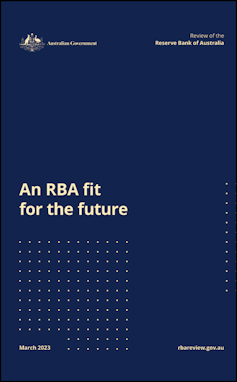
The review into the Reserve Bank of Australia has just been published by Treasurer Jim Chalmers, and it’s a blockbuster.
The review has made 51 recommendations including:
taking away power over interest rates from the Reserve Bank board (which has traditionally been dominated by non-economists, usually corporate executives) and devolving it to a panel of experts
-
reducing the number of decision-making meetings from 11 to eight per year
boosting the transparency of its decision-making process and holding it more accountable for those decisions.
Chalmers offered in-principle agreement to all 51 of the panel’s recommendations and said he would be seeking support from the Opposition for any legislation needed to implement them. The review has briefed Opposition Treasury spokesman Angus Taylor on its thinking.
Chalmers set up the three-person review in July 2022, appointing Carolyn Wilkins, a former senior deputy governor of the Bank of Canada, Renée Fry-McKibbin, of the Crawford School of Public Policy at the Australian National University, and
Gordon de Brouwer, a specialist in public sector reform.
What was the problem?
While the apparent nature of the problem has changed over time, its root cause remains the same.
When the concept of the review was first mooted in 2020, the economy was in a bad state with inflation well below the bank’s target band of 2-3% and economic growth anaemic.
As a result, wage growth was too low and unemployment too high.
The most likely explanation is that the bank was focused too much on stabilising the financial system and too little on boosting the economy.
The bank was setting interest rates using its gut instead of its brain, in an almost literal sense – it was not doing what its computer model suggested it should do.

RBA Review
As the inquiry started, the problem had flipped. Inflation was too high.
But the underlying problem – that the board was populated by monetary policy amateurs rather than experts – remained the same.
The review concluded that monetary policy is a complex area of public policy and is best run by a team of experts who are highly informed about the current state of the economy.
Just as we have the country’s smartest legal minds on the High Court of Australia and our best health practitioners setting vaccine policy, it felt we should have Australia’s best macroeconomic minds running monetary policy at the Reserve Bank of Australia.
This lack of reliance on expertise might help explain why the bank made the ill-fated decision to indicate that interest rates would remain near 0% until 2024.
During the pandemic, bank staff explicitly recommended against forecasting how long interest rates would remain at 0%.
But the bank board ignored this advice and instead set out a three-year projection for how long rates would stay low.
When the economy recovered far quicker than expected and interest rates had to rise, many Australians interpreted the about-face as a broken promise.
Read more:
The RBA's failure to cut rates faster may have cost 270,000 jobs
Culture club
The review says former and current staff have told it the bank’s culture is hierarchical and risk-averse.
It is obviously less than ideal to have an important institution in which diversity of thought is discouraged and staff feel unable to speak up.
Accordingly, the review has recommended that the bank improve its culture by appointing a chief operating officer with a mandate to open up the bank up to new ideas and staff and break down silos within the bank.
What’ll this mean for rates?
Whatever is changed as a result of the review, there are unlikely to be significant changes to its current approach of keeping interest rates relatively high.
Rates will remain high for as long as inflation is projected to stay above the 2-3% target band. The latest official inflation reading was 7.8%. It will be updated next Wednesday.
The review considered whether or not the 2-3% target remains optimal and concluded that it does. It considered alternatives such as a higher inflation target or targeting nominal gross domestic product, and found them lacking.
It recommends that a new monetary policy board meet eight times a year, rather than the 11 times the present board meets. It says this will give the external expert members of the board greater scope to “do deeper and better preparatory work for
each meeting”, helping them make better decisions.
 Reserve Bank Governor Philip Lowe.
Mick Tsikas/AAP
What about RBA Governor Philip Lowe?
A review that found the bank was in good working order would have been a good reason to reappoint the present governor, whose five-year term ends in September.
The scale of the changes recommended by the review is large – there is an entire section devoted to a year-long implementation process.
The government might well decide that Lowe is the right person to carry out that process and that his term should be extended rather than dropping his successor into the middle of it.
However Chalmers plans to handle it, the review he commissioned has ushered in a revolution at the bank – one that will hopefully make it stronger, smarter and better-placed to serve the Australian people.
Reserve Bank Governor Philip Lowe.
Mick Tsikas/AAP
What about RBA Governor Philip Lowe?
A review that found the bank was in good working order would have been a good reason to reappoint the present governor, whose five-year term ends in September.
The scale of the changes recommended by the review is large – there is an entire section devoted to a year-long implementation process.
The government might well decide that Lowe is the right person to carry out that process and that his term should be extended rather than dropping his successor into the middle of it.
However Chalmers plans to handle it, the review he commissioned has ushered in a revolution at the bank – one that will hopefully make it stronger, smarter and better-placed to serve the Australian people.
Source


